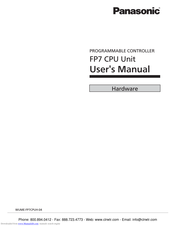Panasonic AFP7PG02L Manuals
Manuals and User Guides for Panasonic AFP7PG02L. We have 2 Panasonic AFP7PG02L manuals available for free PDF download: User Manual
Panasonic AFP7PG02L User Manual (206 pages)
Pulse Output Unit
Brand: Panasonic
|
Category: Controller
|
Size: 8 MB
Table of Contents
Advertisement
Panasonic AFP7PG02L User Manual (109 pages)
CPU Unit
Brand: Panasonic
|
Category: Controller
|
Size: 2 MB

